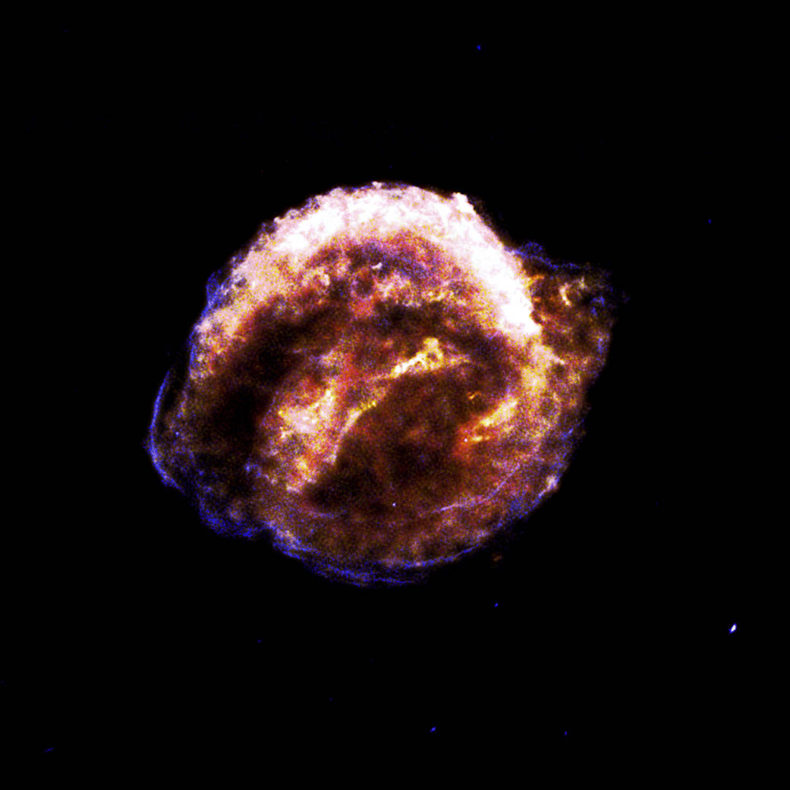
Space is this abstract concept to lots of you. I know so many people, including so many writers, who could not care less about the subject. They are bored, at best, by everything that exists beyond the eggshell-thin layer of this planet’s atmosphere. The wild, kaleidoscopic kingdom of life on this world is enough for them. As much as I love living things, I will never understand this perspective.
Antipathy about space vs. SPACE!!1! is an old argument and it’s one I have held with friends for years, and so I don’t feel like re-litigating it. But allow me to enter into evidence, if you will, a new finding that should remind you of how space is not far at all, but near, and part of us all, and a force in all our lives.
Trees can absorb the shockwaves of supernovas, and record them for posterity.
Trees are plants, which produce their own food using ingredients from space—the Sun—and from Earth, including water, carbon dioxide, and nutrients. They inhale carbon dioxide through their leaves, and mix it with sunlight in a tree-building process we call photosynthesis. While they take up carbon mostly from Earth, they also soak up trace amounts forged by processes from much more distant reaches. Some of the carbon in Earth’s atmosphere is a radioactive kind called carbon-14.
Carbon-14 forms in the aftermath of colliding cosmic rays and nuclear blasts. It is produced in the atmosphere when a wayward cosmic ray slams into nitrogen atoms, knocking around their protons and neutrons and transforming them into carbon atoms. Carbon-14 breaks down on a predictable timeline, so you can figure out how old something is by looking at its relative quantity of carbon-14. Tree rings also form on a predictable timeline, so you can use them to determine how old a tree is, or what was happening in the atmosphere at a given time. Combining them tells. you something about what was happening in space at a given time, according to this new research.
Sometimes carbon-14 levels spike, which in the recent past indicates a nuclear detonation, although through most of Earth history C-14 has indicated a much more distant explosion, like one from the Sun.
A scientist at the University of Colorado investigated carbon-14 in tree rings and found several spikes, which he argues might be from supernova explosions instead of emanations from our nearest star.
A star, like a tree and like anyone who has ever lived, has a finite lifespan. When stars die, some of them begin to fall apart and collapse on themselves, until the pressure and crushing gravity become so intense that they explode, forming a supernova. Supernovas release absurd amounts of energy and radiation, including the kind of gamma rays that can trigger C-14 to form on Earth.
Robert Brakenridge of CU went back through the supernova record, which is a thing we have, and then compared them to the tree ring record, which is also a thing that we have. Eight of the nearest supernovas within the last 40,000 years seemed to be associated with spikes in C-14. Four of those are especially tantalizing, according to a paper Brakenridge published in the International Journal of Astrobiology. One of them was a star in the southern sky’s Vela constellation, which exploded about 13,000 years ago. Apparently C-14 levels jumped by three percent after the stellar explosion, a suspicious correlation. Brakenridge goes so far as to say these explosions may have been tied to previous extinctions.
All of this is far from conclusive; it’s hard to tease out a supernova signal from the variety of factors that influence C-14 formation and C-14 ratios. But Brakenridge says it’s worth further study. I’ve written about similar work before, including whether a supernova 2.6 million years ago could have contributed to a Pliocene-Pleistocene extinction. I have to agree that this is at the very least super compelling, and worth your consideration.
Just think about it. Step back for a second, forget about the electoral crisis and the pandemic and the holidays and the weather. You are on a spinning rock orbiting an ordinary star in a universe that is full of heat and light. The death throes of ancient stars that died hundreds and thousands and millions of years ago at unspeakable distances from you are nevertheless recorded right here, within the bodies of our cohabitants.
Space is not distant. Stars are not weak glints in the sky. They are part of you. Their remains course through your veins right now; the iron in your blood also formed in their innards, and scattered to the cosmic winds when they died. Stars imprint themselves on everything that lives. Earth and its attendant circus of life may be the only habitable place we’ve found, at least so far, but that does not mean Earth or its life are isolated. We are very much not alone in the void. Don’t tell me space isn’t interesting.
—
Image: A nebula remnant from a supernova witnessed by Johannes Kepler in 1604. NASA/Chandra X-Ray Observatory